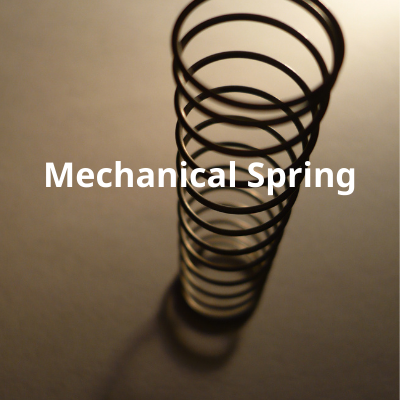
Introduction to Mechanical Spring
Mechanical Spring is an elastic element widely used in the mechanical and electronic industries.
The spring can produce large elastic deformation when loaded, and convert mechanical work or kinetic energy into deformation energy, and the deformation of the spring disappears and returns to its original state, the deformation energy is converted into mechanical work or kinetic energy at the same time.
The ratio of spring load to deformation is called spring stiffness. The greater the stiffness, the harder the spring.
The Purpose of the Spring
- Cushioning and damping. Such as damping springs under cars and train cars, buffer springs of various buffers, etc.
- Control the movement of the mechanism. Such as valve springs in internal combustion engines, control springs in clutches, etc.
- Store and output energy. Such as clock springs, gun bolt springs, etc.
- Measure the size of the force. Such as spring scales, springs in dynamometers, etc.
Types of Springs
According to the nature of the force, the spring is divided into: extension spring, compression spring, torsion spring and bending spring.
Extension Springs
Extension springs are helical springs that bear axial tension. Extension springs are generally made of round cross-section materials. When not under load, the coils of the tension spring are generally tight and there is no gap.
Compression Springs
Compression springs are helical springs that bear the pressure. Most of the materials used are circular in cross-section, and they are also rolled with rectangular and multi-stranded steel coils.
The springs are generally of equal pitch. There is a certain amount between the coils of the compression spring. When receiving external load, the spring shrinks and deforms to store deformation energy.
Torsion Springs
Torsion springs are helical springs. The torsion spring can store and release angular energy or rotate the arm around the central axis of the spring body to statically fix a device.
The ends of the torsion spring are fixed to other elements, and when the other elements rotate around the center of the spring, the spring pulls them back to their original positions, generating torque or rotational force.
Air Spring
Air spring is a kind of non-metallic spring that adds pressurized air into a flexible airtight container and uses the compressibility of air to achieve elastic action. Used in the suspension device of high-end vehicles can greatly improve the ride comfort of the vehicle, thereby greatly improving the performance of the vehicle.
Comfort, so air springs have been widely used in automobiles and railway locomotives.
Carbon Nanotube Spring
Carbon nanotube spring is necessary to first make a carbon nanotube film, and then use spinning technology to spin the carbon nanotube film into a carbon nanotube spring. The diameter can reach hundreds of microns, and the length can reach several centimeters.
It is expected to be used in fields such as stretchable conductors, flexible electrodes, miniature strain sensors, supercapacitors, integrated circuits, solar cells, field emission sources, energy dissipation fibers, etc. , Is also expected to be applied to medical devices, such as tension sensing bandages.
Spring Production
The manufacturing process of the spiral spring includes: rolling, hook making or finishing of the end face ring, heat treatment and process efficiency test.
In mass production, it is rolled on a universal automatic spring coiling machine; in single-piece and small batch production, it is made on a common lathe or by hand.
When the diameter of the spring wire is less than or equal to 8mm, the cold rolling method is commonly used, heat treatment is required before coiling, and low temperature tempering after coiling.
When the diameter is greater than 8mm, the hot coil (hot coil temperature 800℃~1000℃) method is adopted. After the hot coil is quenched and tempered at medium temperature, the surface quality inspection should be carried out after the spring is formed.
The surface should be smooth, free of scars, and free of detachment. Defects such as carbon; springs subjected to variable loads must be surface treated such as shot peening to increase the fatigue life of the springs.
Mechanical Spring Precautions
In actual work, the compression spring should be able to maintain its working length even if it is subjected to a force beyond the elastic limit of the material.
Therefore, the length of the finished spring should be equal to the calculated length of the spring plus the initial compression, which can prevent the spring from being out of place, so as to avoid dangerous stress when the coil is tightened, which may cause the spring indicator line to be abnormal and not in place.
In the heat treatment process of the finished spring, especially the hardening and tempering process, the workpiece must be placed horizontally (horizontally) in the furnace to prevent the spring from being shortened due to its own weight and the operation is not in place.
Get more info, please visit our CNC Turning Parts or Products.
Contact us for your customized metal parts.